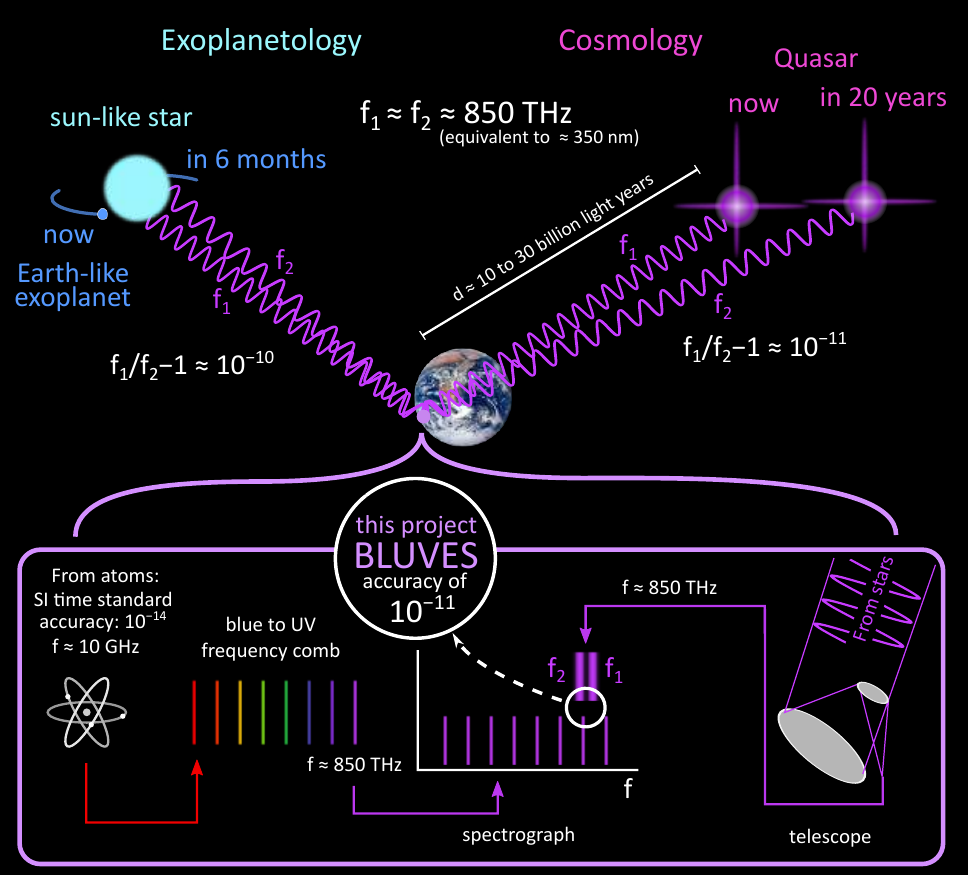BLUVES: A Blue Laser Frequency Comb for VLT/Espresso
- 1Observatory of Geneva, Switzerland
- 2Swiss Center for Electronics and Microtechnology, Neuchâtel (CSEM)
- 3Deutsches Elektronen-Synchrotron, Hamburg (DESY)
In the last decade, laser frequency combs (LFCs) have been established as the ideal wavelength calibration source for high-resolution, high-precision astronomical spectroscopy. LFCs provide a dense train of equally spaced and extremely narrow lines which frequencies are directly linked to the fundamental time reference of the SI second. This – at least in principle – allows to derive wavelength solutions orders of magnitude more precise and accurate than possible with conventional calibration schemes, essential in particular within the context of radial velocity studies of exoplanets and the hunt for habitable planets around solar-type stars. In addition, the great number and narrow width of LFC lines allows a precise characterization of astronomical spectrographs, e.g. of the line-spread function, relevant for atmospheric characterization by transit spectroscopy. Also, LFCs are the only type of calibration source that can provide the extreme accuracy needed for tests of fundamental physics on cosmological scales, e.g. the variation of the fine-structure constant or the direct observation of the expansion of the Universe (Sandage test). Therefore, future high-resolution spectrographs like ELT/HIRES will rely entirely, or at least predominantly, on LFCs for wavelength calibration.
However, the LFCs currently in operation with e.g. HARPS or Espresso do not cover the blue spectral range. They only provide flux to slightly bluewards of 500nm. This leaves a very significant part of the spectrographs spectral range (e.g. 43% for Espresso) without LFC coverage and does not permit the LFC to be used as primary wavelength reference. The reason behind this is that suitable laser gain media are all located in the near-IR and 'spectral broadening' by non-linear optical effects is necessary to bring the light into the visible domain. Therefore, covering the blue and near-UV range of the spectrum with astronomical LFCs is an intrinsically hard problem that has so far not been mastered in practice.
To overcome this issue, BLUVES (BLue to UV Extreme precision astronomical Spectroscopy) is an interdisciplinary collaboration between the Observatory of Geneva, the Swiss Center for Electronics and Microtechnology (CSEM), the Deutsches Elektronen-Synchrotron (DESY), ESO and others with the aim of developing a laser frequency comb covering the blue and near-UV spectral range down to the atmospheric cut-off at 350nm.
To achieve this challenging goal, a set of novel and innovative technologies have to be developed over the next years.
One key aspects here is the use of an electro-optic modulation comb which can directly produce the large required line separation of 15 to 20GHz without the need for mode-filtering in Fabry-Perot cavities (E. Obrzud et al. 2018).
Even more important will be the approach for harmonic driven supercontinuum generation. This will involve the development of an integrated optical chip containing a lithium-niobate waveguide that facilitates second- and third-harmonic generation as well as spectral broadening (E. Obrzud et al. 2019).
In parallel to this, we are investigating novel wavelength-calibration methods and algorithms needed to actually make use of the precision and accuracy provided by the LFC. A careful study of the Espresso wavelength solution revealed multiple types of systematics that had not been seen before (T. Schmidt et al. 2021). Pushing to higher accuracy and precision will unavoidably require improved techniques to eliminate or correct for the observed effects. This does not only involve new software but also requires a tunable LFC to accurately characterize the instrument properties in detail, which again highlights the importance of an LFC system that covers the full spectral range of the spectrograph.
We will present the current status of the BLUVES project, its key aspects and the expected development over the next years.

How to cite: Schmidt, T., Bouchy, F., Brasch, V., Herr, T., Pepe, F., and Lovis, C.: BLUVES: A Blue Laser Frequency Comb for VLT/Espresso, European Planetary Science Congress 2021, online, 13–24 Sep 2021, EPSC2021-323, https://doi.org/10.5194/epsc2021-323, 2021.

